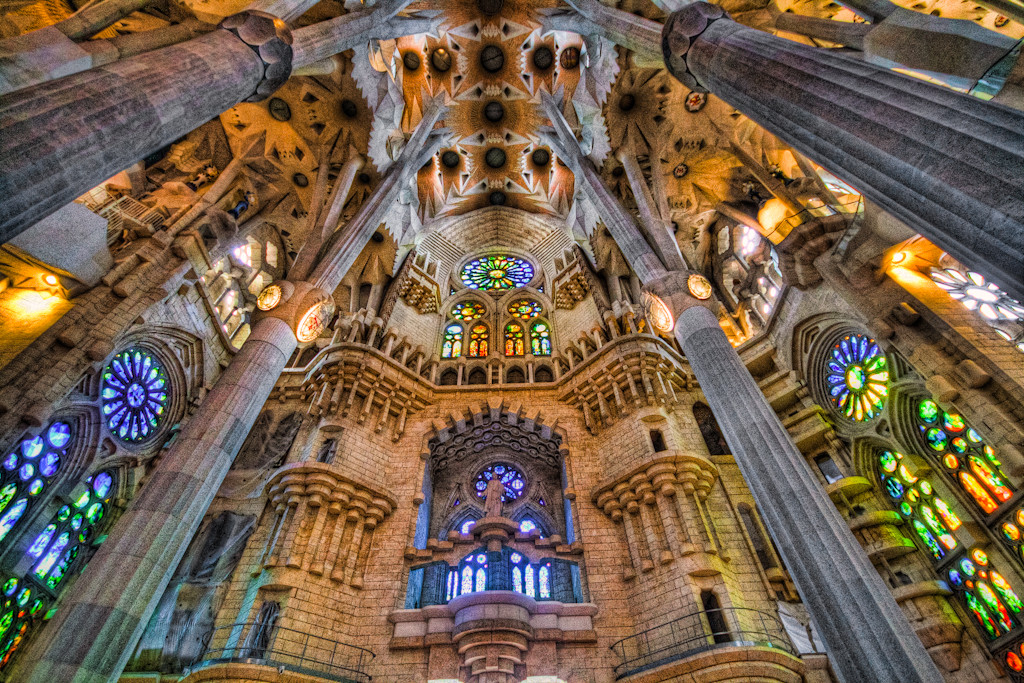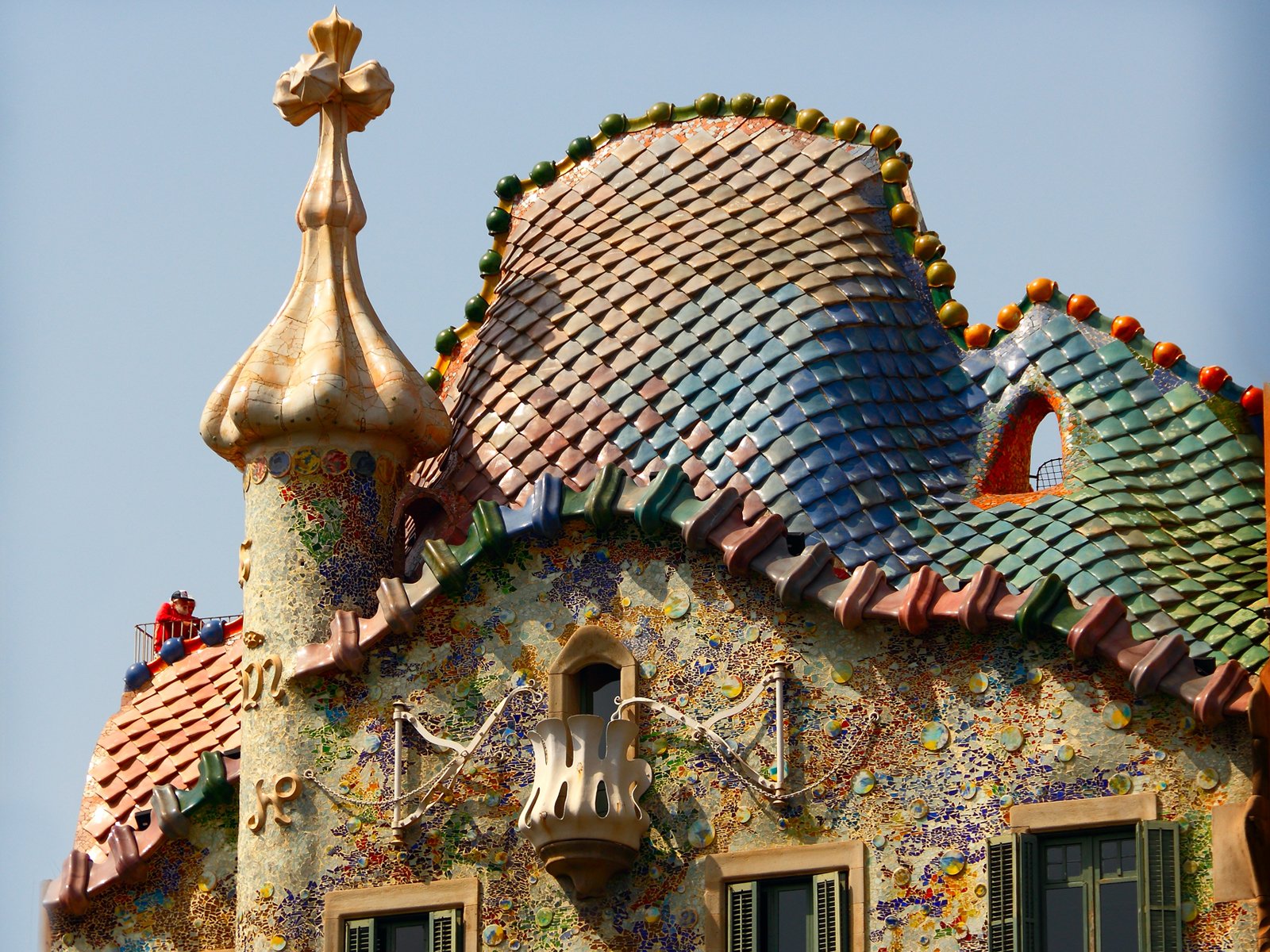 Every visitor of Barcelona notices an indelible imprint of creativity and enigmatic wizardtry. Antoni Gaudi is responsible for the unique, defining architectural style of the capital of Catalonia.
Every visitor of Barcelona notices an indelible imprint of creativity and enigmatic wizardtry. Antoni Gaudi is responsible for the unique, defining architectural style of the capital of Catalonia.
Gaudi’s Barcelona sparkles like a fairy tale, embodied in his architecture. If feels strange knowing that the houses he created are occupied by real people, living very normal lives. Gaudi attained a unique status among the rich Barcelonians. His building posses not only esthetic value, but are incredibly functional and comfortable to live in.
1. Sagrada Familia 
 The most majestic and famous building designed by Antonio Gaudi is still not finished yet! Sagrada Familia, which strike Barcelonians and city visitors with its immense power in the Gracia District, has been the scene of nearly continuous construction with minor interruptions for nearly 133 years
The most majestic and famous building designed by Antonio Gaudi is still not finished yet! Sagrada Familia, which strike Barcelonians and city visitors with its immense power in the Gracia District, has been the scene of nearly continuous construction with minor interruptions for nearly 133 years

 “Either man plays God, creating such masterpieces, whether God plays a man bearing in his mind such ideas,” – said one of the researchers of Antonio Gaudi, frozen in a daze near the Sagrada Familia. Spain’s most famous temple is really amazing. It towers over Barcelona, like a huge cave with a bell tower in the form of stalactites and deep caves, captivating into the mysterious temple.
“Either man plays God, creating such masterpieces, whether God plays a man bearing in his mind such ideas,” – said one of the researchers of Antonio Gaudi, frozen in a daze near the Sagrada Familia. Spain’s most famous temple is really amazing. It towers over Barcelona, like a huge cave with a bell tower in the form of stalactites and deep caves, captivating into the mysterious temple.

 Gaudi’s ideas were bold and on a truly grand scale.The height of the finished cathedral – 170 meters – just a meter less than the height of the highest mountain in Barcelona. So Gaudí wanted to emphasize that the creation of man can not be higher than God’s creation. The main door of the Passion facade reproduces the words of the Bible in different languages, including Catalan
Gaudi’s ideas were bold and on a truly grand scale.The height of the finished cathedral – 170 meters – just a meter less than the height of the highest mountain in Barcelona. So Gaudí wanted to emphasize that the creation of man can not be higher than God’s creation. The main door of the Passion facade reproduces the words of the Bible in different languages, including Catalan

 It is not known exactly how the temple would have appeared, if it had been built before Gaudí’s death, because some of the drawings were destroyed by fire during the Spanish Civil War. But in any case, the final draft of the temple, which construction should be completed around 2030, never ceases to amaze one’s imagination.
It is not known exactly how the temple would have appeared, if it had been built before Gaudí’s death, because some of the drawings were destroyed by fire during the Spanish Civil War. But in any case, the final draft of the temple, which construction should be completed around 2030, never ceases to amaze one’s imagination.
2. Park Güell 
 Today, it is in fact a real park of dense groves of pines and endless palm avenues in the northwest part of town. On the spacious terrace surrounded by trees pensioners and loversmeet and talk.
Today, it is in fact a real park of dense groves of pines and endless palm avenues in the northwest part of town. On the spacious terrace surrounded by trees pensioners and loversmeet and talk.

 When Gaudi began to work in Barcelona, the park was not in anyone’s mind. There were no water sources, the area looked deserted, trees didn’t grow on the hillside. Now it’s a lush, green world created by Antonio Gaudi.
When Gaudi began to work in Barcelona, the park was not in anyone’s mind. There were no water sources, the area looked deserted, trees didn’t grow on the hillside. Now it’s a lush, green world created by Antonio Gaudi.

 However, there could be no park: Eusebio Guell, Gaudi’s admirer and employer, raised his hand for more. His dream was to see the area turned into a residential paradise; a garden city that would touch the soul of all who came.
However, there could be no park: Eusebio Guell, Gaudi’s admirer and employer, raised his hand for more. His dream was to see the area turned into a residential paradise; a garden city that would touch the soul of all who came.
3. Torre Bellesguard 
 In 1900 the famous architect was commissioned to build a country house for Mary Sages. According to his plan, the building had to reflect the significant milestones in the history of Catalonia. The choice was not accidental. But to remember in Spain and Catalonia in particular the great people were customarily glorified in this way.
In 1900 the famous architect was commissioned to build a country house for Mary Sages. According to his plan, the building had to reflect the significant milestones in the history of Catalonia. The choice was not accidental. But to remember in Spain and Catalonia in particular the great people were customarily glorified in this way.
The layout of the structure was simple, but artfully decorated with neo-gothic elements: wrought iron grilles, elegant spires and trim battlements on the walls. The entrance to the castle was adorned with elegant ceramic mosaics, which symbolized the power of Catalonia ruling the seas.
 Gaudi used materials that remained from the ruins of the palace, which had stood on the site before giving the construction a special grace.
Gaudi used materials that remained from the ruins of the palace, which had stood on the site before giving the construction a special grace.
4. Casa Milá
 Casa Milá – one of the best examples of the architectural concept of Antoni Gaudi. Someone said its facade resembles waves rolling, others – a mountain of stones with caves. Barcelonians even jokingly call it La Pedrera (‘the quarry’).
Casa Milá – one of the best examples of the architectural concept of Antoni Gaudi. Someone said its facade resembles waves rolling, others – a mountain of stones with caves. Barcelonians even jokingly call it La Pedrera (‘the quarry’).

 While constructing this house, Gaudi as always drew his inspiration from nature. As a result building seems totally alive and moving, one can distinguish the cave, sea, underwater world.
While constructing this house, Gaudi as always drew his inspiration from nature. As a result building seems totally alive and moving, one can distinguish the cave, sea, underwater world.

 The view from the top of it is also marvelous, there are no fences and it looks like the gardens and mysterious figures are hanging over the precipice.
The view from the top of it is also marvelous, there are no fences and it looks like the gardens and mysterious figures are hanging over the precipice.
5. Casa Batlló
 With this project Gaudi proved – old things have their own charm; he breathed new life into the old building and made it charming and magical.
With this project Gaudi proved – old things have their own charm; he breathed new life into the old building and made it charming and magical.

 Casa Batlló has almost no straight lines; wavy shapes – this is the technique Gaudi prefered and this is what sets him apart from the other architects.
Casa Batlló has almost no straight lines; wavy shapes – this is the technique Gaudi prefered and this is what sets him apart from the other architects.

 The main facade of the Casa Batlló is quite symbolic. It has different interpretations, but the most famous and precise one is the comparison to the gigantic dragon.
The main facade of the Casa Batlló is quite symbolic. It has different interpretations, but the most famous and precise one is the comparison to the gigantic dragon.
6. Casa Vicens
 Casa Vicens was the first creation in the significant Gaudi’s architectural collection. It was constructed between 1882 – 1888.
Casa Vicens was the first creation in the significant Gaudi’s architectural collection. It was constructed between 1882 – 1888.
Casa Vicens looks extremely creative, taking into account that it was built for a wealthy family to carry out their everyday lives, including extensive entertaining and living on a very grand scale.
 There is an Islamic touch in the facade and in some rooms decoration which adds a charm of Oriental culture to the impressive creation. You’ll find this masterpiece in Gracia district.
There is an Islamic touch in the facade and in some rooms decoration which adds a charm of Oriental culture to the impressive creation. You’ll find this masterpiece in Gracia district.
7. Casa Calvet  This is perhaps the least known of all of Gaudi’s projects, because of its “overly traditional design”. Symmetrical and balanced shapes were not usual for Gaudi’s style.
This is perhaps the least known of all of Gaudi’s projects, because of its “overly traditional design”. Symmetrical and balanced shapes were not usual for Gaudi’s style.
If you fail to look closely, the building seems ordinary and unremarkable. But it is only at first glance. Despite the classic layout and smooth walls, the art Baroque style is very interesting. The decoration of the facade is quite original, and not repeated in other houses by the architect.
Besides the unique design Casa Calvet is extremely functional. It was built for the textile industrialist Andrew Calvet. It was used both as a residential house and as an industrial building.
